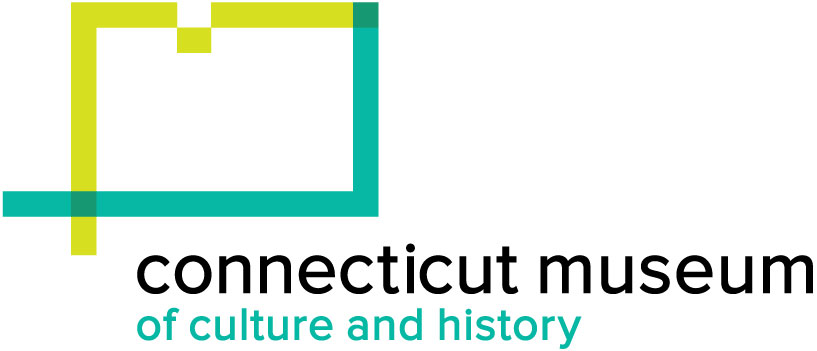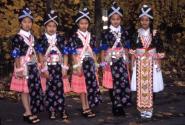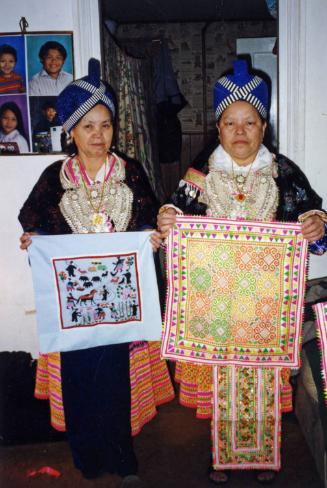SNEAP Year 1: Hmong Textile Arts & Hmong New Year, 1998
SubjectPortrait of
Blia Vang
(Hmong)
SubjectPortrait of
Vang Xiong
(Hmong)
SubjectPortrait of
Yee Xiong
(Hmong)
SubjectPortrait of
Pa Koua Vang
(Hmong)
SubjectPortrait of
Mai Sia Thao
(Hmong)
Date1998-1999
Mediumpositive color film slides
ClassificationsGraphics
Credit LineConnecticut Cultural Heritage Arts Program collections
CopyrightIn Copyright
Object number2015.196.544.1-.62
Description2015.196.544.1-.31 and 2015.196.544.56-.62 are photographs from the teaching session and required public presentation of the Southern New England Apprentice Program Year 1 team in Hmong embroideries, stories, and songs with teaching artist Blia Vang and apprentices Vang Xiong and Yee Xiong. The public presentation took place at the Xiong's home with their family.
(.1-.7): Images of Hmong textile artists Blia Vang and Vang Xiong embroidering story cloths.
(.8) Image of four Hmong women. Pictured left to right are an unidentified woman, Vang Xiong, Blia Vang, and Yee Xiong.
(.9-.11) Images of Hmong textile artist Vang Xiong sewing a story cloth.
(.12) Image of four Hmong women. Pictured left to right are an unidentified woman, Vang Xiong, Blia Vang, and Yee Xiong.
(.13) Image of Hmong textile artist Blia Vang.
(.14) Image of Hmong textile artist Yee Xiong.
(.15) Image of Hmong textile artist Vang Xiong sewing a story cloth.
(.16-.17) Images of Pa Koua Vang playing a Hmong two-string violin.
(.18-.19) Images of a young man showing a belt and a front piece of his traditional outfit.
(.20) Image of Vang Xiong with a story cloth.
(.21) Image of Blia Vang in a traditional costume holding an embroidered cloth.
(.22) Image of Pa Koua Vang with his grandchild and a traditional instrument. Photo taken by Winifred Lambrecht.
(.23) Image of Vang Xiong and a young man with an embroidered fabric on the table.
(.24) Image of three Hmong women looking at embroidered story cloths. Pictured left to right are an unidentified woman, Vang Xiong, and Blia Vang.
(.25) Image of Blia Vang and Vang Xiong in traditional Hmong dress. Vang is holding an embroidered cloth they worked on during the apprenticeship.
(.26) Image of an embroidered baby carrier made by Yee Xiong.
(.27-.29) Images of Yee Xiong showing embroidered baby carriers she has made.
(.30) Image of Vang Xiong playing the flute.
(.31) Image of Vang Xiong playing the mouth harp.
(.32) Image of young girl wearing traditional clothes made by Yee Xiong.
2015.196.544.33-.45 and 2015.196.544.48 are photographs of Hmong community members in traditional dress at Hmong New Year 1998.
(.33) Image of Mai Sia Thao with Hmong girls wearing traditional clothes.
(.34-.36) Images of Hmong girls wearing traditional clothes.
(.37) Image of Hmong boys wearing traditional clothes.
(.38) Image of Mai Sia Thao wearing traditional clothes.
(.39) Close up image of Mai Sia Thao's embroidered apron.
(.40) Image of Hmong boys wearing traditional clothes.
(.41-.42) Images of Hmong boy wearing traditional clothes.
(.43-.45) Images of Hmong girls wearing traditional clothes.
(.46) Image of an embroidered baby carrier made by Yee Xiong, in the collection of the Connecticut Historical Society.
(.47) Close-up of an embroidered baby carrier made by Yee Xiong
(.48) Close up image of Vang Xiong's embroidered apron.
(.49) Image of Vang Xiong in the traditional outfit she made.
(.50) Image of an embroidered baby carrier made by Yee Xiong.
(.51) Image of Vang Xiong in the traditional outfit she made.
(.52) Image of a detail of the construction of a traditionally-made skirt.
(.53) Image of Vang Xiong in the traditional outfit she made.
(.54-.55) Images of a detail of the construction of a traditionally-made skirt.
(.56) Image of Vang and Yee Xiong looking at clothes they have made.
(.57) Image of Vang Xiong in a traditional hat she made.
(.58-.62) Images of details of traditional clothes made by Vang and Yee Xiong for their families.
NotesSubject Note: The Southern New England Traditional Arts Apprenticeship Program is a CCHAP initiative since 1997 that fosters the sharing of community-based traditional (folk) artistic skills through the apprenticeship learning model of regular, intensive, one-on-one teaching by a skilled mentor artist to a student/apprentice. The program pairs master artists from Rhode Island, Massachusetts, or Connecticut with apprentices from one of the other states, as a way to knit together members of the same community or group across state lines. Teaching and learning traditional arts help to sustain cultural expressions that are central to a community, while also strengthening festivals, arts activities and events when master/apprentice artists perform or demonstrate results of their cooperative learning to public audiences. The Connecticut Cultural Heritage Arts Program at the Connecticut Historical Society manages the program in collaboration with the Folk Arts Program at the Massachusetts Cultural Council and independent folklorist Winifred Lambrecht who has a deep knowledge of the folk arts landscape of Rhode Island. Primary funding for the program comes from the National Endowment for the Arts, with support also from the Connecticut Commission on the Arts, the Institute for Community Research, and the Connecticut Historical Society.(.1-.7): Images of Hmong textile artists Blia Vang and Vang Xiong embroidering story cloths.
(.8) Image of four Hmong women. Pictured left to right are an unidentified woman, Vang Xiong, Blia Vang, and Yee Xiong.
(.9-.11) Images of Hmong textile artist Vang Xiong sewing a story cloth.
(.12) Image of four Hmong women. Pictured left to right are an unidentified woman, Vang Xiong, Blia Vang, and Yee Xiong.
(.13) Image of Hmong textile artist Blia Vang.
(.14) Image of Hmong textile artist Yee Xiong.
(.15) Image of Hmong textile artist Vang Xiong sewing a story cloth.
(.16-.17) Images of Pa Koua Vang playing a Hmong two-string violin.
(.18-.19) Images of a young man showing a belt and a front piece of his traditional outfit.
(.20) Image of Vang Xiong with a story cloth.
(.21) Image of Blia Vang in a traditional costume holding an embroidered cloth.
(.22) Image of Pa Koua Vang with his grandchild and a traditional instrument. Photo taken by Winifred Lambrecht.
(.23) Image of Vang Xiong and a young man with an embroidered fabric on the table.
(.24) Image of three Hmong women looking at embroidered story cloths. Pictured left to right are an unidentified woman, Vang Xiong, and Blia Vang.
(.25) Image of Blia Vang and Vang Xiong in traditional Hmong dress. Vang is holding an embroidered cloth they worked on during the apprenticeship.
(.26) Image of an embroidered baby carrier made by Yee Xiong.
(.27-.29) Images of Yee Xiong showing embroidered baby carriers she has made.
(.30) Image of Vang Xiong playing the flute.
(.31) Image of Vang Xiong playing the mouth harp.
(.32) Image of young girl wearing traditional clothes made by Yee Xiong.
2015.196.544.33-.45 and 2015.196.544.48 are photographs of Hmong community members in traditional dress at Hmong New Year 1998.
(.33) Image of Mai Sia Thao with Hmong girls wearing traditional clothes.
(.34-.36) Images of Hmong girls wearing traditional clothes.
(.37) Image of Hmong boys wearing traditional clothes.
(.38) Image of Mai Sia Thao wearing traditional clothes.
(.39) Close up image of Mai Sia Thao's embroidered apron.
(.40) Image of Hmong boys wearing traditional clothes.
(.41-.42) Images of Hmong boy wearing traditional clothes.
(.43-.45) Images of Hmong girls wearing traditional clothes.
(.46) Image of an embroidered baby carrier made by Yee Xiong, in the collection of the Connecticut Historical Society.
(.47) Close-up of an embroidered baby carrier made by Yee Xiong
(.48) Close up image of Vang Xiong's embroidered apron.
(.49) Image of Vang Xiong in the traditional outfit she made.
(.50) Image of an embroidered baby carrier made by Yee Xiong.
(.51) Image of Vang Xiong in the traditional outfit she made.
(.52) Image of a detail of the construction of a traditionally-made skirt.
(.53) Image of Vang Xiong in the traditional outfit she made.
(.54-.55) Images of a detail of the construction of a traditionally-made skirt.
(.56) Image of Vang and Yee Xiong looking at clothes they have made.
(.57) Image of Vang Xiong in a traditional hat she made.
(.58-.62) Images of details of traditional clothes made by Vang and Yee Xiong for their families.
Subject Note: The Hmong community in Connecticut, around 300 in number, is based mostly in the Enfield and Manchester areas. They work in factories and service occupations, as well as skilled manufacturing, often in aerospace industries. The Hmong came to the United States as refugees from the Indochina wars in the 1970s after the Communist takeover of Laos, sponsored by the American government because many Hmong assisted the military and the CIA. At that time the Hmong were persecuted in Laos, and this still continues today with considerable fighting going on. The Hmong are a tribal group originally from Mongolia who migrated to Laos where many still live today. There are also Hmong communities in northern Burma, Vietnam, Thailand, and China (where they are called Miao).
Connecticut Hmong people are both traditional and contemporary. Older women used to make the gorgeous applique and embroidery work known as paj ndau, and they still create traditional costumes for women and men, albeit with modern shortcuts (traditional dyeing techniques are replaced by printed cloth, for instance). Men who are traditional community leaders, such as Boua Tong Xiong, still perform wedding and funeral rituals, as well as conflict resolution according to time-honored practices. Hmong traditions practiced in Connecticut include embroidery and story cloths, funeral and wedding songs, music on the bamboo instrument qeej, ballads and courtship songs kwv ntxhiaj, and social dancing. Hmong leaders started the Hmong Foundation of Connecticut as a way to keep the community together and continue to provide many kinds of needed assistance. The Foundation, which is led by a Board of Directors, is open to all Hmong living in the state. Members provide services such as translation, transportation, family relocation to Connecticut, assistance with finding jobs and access to health care, Hmong language classes, and traditional Hmong advising and dispute resolution. The Hmong Foundation of Connecticut became a separate organization in 1996 after the Connecticut Federation of Refugee Assistance Agencies, an umbrella service group, disbanded. The group sponsors Hmong New Year in November and a celebration for Hmong high school graduates in June.
The Hmong have a number of sub-cultural groups; one of the distinguishing characteristics of the Blue Hmong is their custom of batiking cloth with blue indigo. One specific kind of textile that the Hmong have become known for are the “story cloths”. These are a comparatively new genre first made in the Thai refugee camps around 1975. In these embroidered pieces, direct figurative references are made to folk tales, myths, personal family stories, and scenes of village life. These story cloths also depict the turbulence and hardships of the war years in Southeast Asia. Hmong textile works also include many references to the natural world, to the plants and animals, which are native to the hills of Laos. (Winifred Lambrecht, Ph.D (CCHAP project partner); July 2006)
Hmong New Year - Nyob Zoo Xyoo Tshiab - is the Hmong community’s most important annual festival. The New Year festival, always held late in the year, includes the ball toss, a game between young people that is a courtship ritual; a fashion show of different tribal costumes; a cultural presentation of dance and song; and a community-prepared feast with traditional foods. The spiritual connotation of the festival is for thanksgiving and new beginnings, and to honor ancestors. Hmong participants wear traditional dress, make speeches, and sing songs appropriate to the celebration. New Year also serves as a reminder and practice of traditions, as well as a gathering of cultural and social leaders.
Biographical Note: Blia Vang emigrated to the U.S. from the hills of Laos in 1979. Highland Laos was the home of thousands of Hmong people who are believed to have come from the Southern provinces of China several generations ago. When Laos was invaded by communist troops in 1975, thousands of Hmong were forced to flee. Blia Vang, her husband Pa Koua Vang, and their children were amongst those who survived under precarious conditions in the jungle, and eventually crossed the Mekong River to find sanctuary in Thai refugee camps. The Hmong were resettled in a number of countries, including the United States, in the late 1970s and 1980s. About 4,000 Hmong were resettled in Rhode Island, mostly in Providence; the number has decreased because of secondary immigration to other states particularly California, North Carolina, and Minnesota. Blia Vang learned Hmong traditional textile arts form her mother and other women in her family, starting when she was eight years old. She is the bearer of a traditional living culture that carries with it centuries of knowledge. The contemporary decorative textiles (or “paj ndau”) include two major forms: applique and stitchery. The applique includes double applique and reverse applique; the stitchery is also of a variety of forms: cross-stitching and embroidery add texture and dimension to most pieces.
Biographical Note: Vang Xiong was a Hmong flute player and embroidery artist of great skill who lived in Tariffville, Connecticut with her family. She was the sister of Boua Tong Xiong. After 2000 she moved to California with some of her family. Contemporary Hmong decorative textiles (or “paj ndau”) include two major forms: applique and stitchery. The applique includes double applique and reverse applique; the stitchery is also of a variety of forms: cross-stitching and embroidery add texture and dimension to most pieces. One of her embroideries is in the CHS collection, collected by Lynne Williamson.
Biographical Note: Yee Xiong was a Hmong embroidery artist of great skill who lived in Tariffville, Connecticut with her family. She was the sister of Boua Tong Xiong. After 2000 she moved to California with some of her family. Contemporary Hmong decorative textiles (or “paj ndau”) include two major forms: applique and stitchery. The applique includes double applique and reverse applique; the stitchery is also of a variety of forms: cross-stitching and embroidery add texture and dimension to most pieces. Some of her embroideries are in the CHS collection, collected by Lynne Williamson.
Biographical Note: Pa Koua Vang is a respected cultural and spiritual leader in the Hmong community, formerly in Providence, Rhode Island and now in Woodbury, Minnesota. He taught Peter Xiong elements of the Hmong wedding ritual from 1999-2000, as part of CCHAP’s Southern New England Traditional Arts Apprenticeship Program. Music, in the form of both singing and playing traditional instruments, is an important part of the ceremonies, and Pa Koua Vang is skilled in these Hmong art forms.
Additional materials exist in the CCHAP archive for these artists and this community.
Cataloging Note: This project was made possible in part by the Institute of Museum and Library Services MA-245929-OMS-20.
Status
Not on view










































































